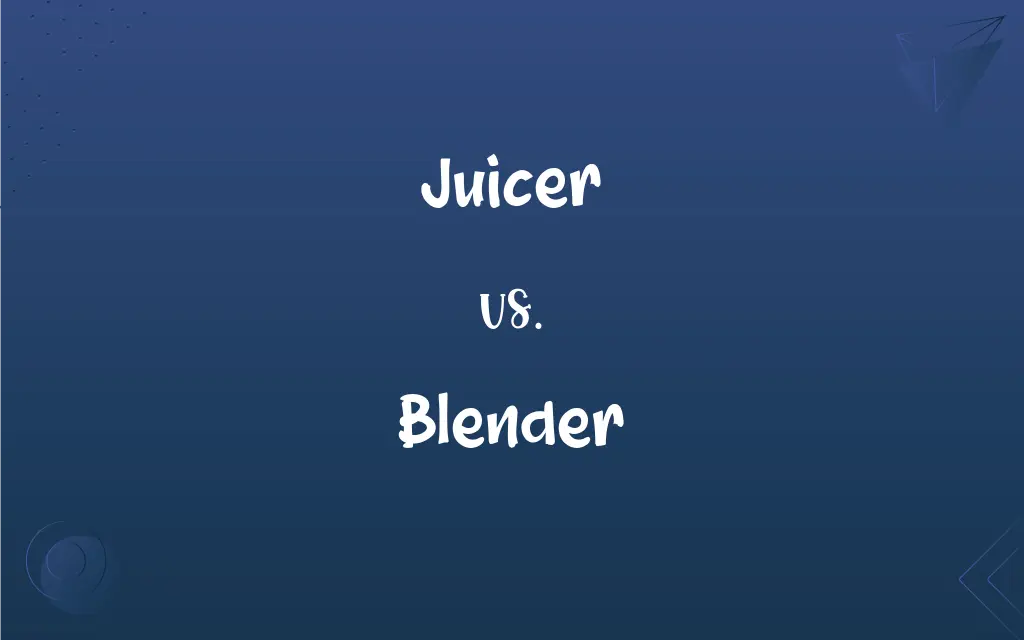Juicer vs. Blender: What's the Difference?
Edited by Aimie Carlson || By Harlon Moss || Updated on July 1, 2024
A juicer extracts juice from fruits and vegetables, while a blender mixes ingredients into a smooth consistency.

Key Differences
A juicer is a device specifically designed to extract juice from fruits and vegetables. This extraction process leaves behind the fibrous pulp, ensuring the user receives a clear, pulp-free juice. On the other hand, a blender is a versatile appliance that blends all components together, creating mixtures with both liquid and solid elements, often resulting in smoothies or purées.
When comparing a juicer to a blender, the juicer tends to be more specialized, targeting those who prioritize juice intake without the pulp. A blender, conversely, is known for its ability to handle a range of ingredients and textures, which can include fruits, vegetables, nuts, and ice.
In essence, while the juicer focuses on drawing out pure liquid, the blender incorporates every aspect of the ingredient, offering a blended consistency.
Comparison Chart
Primary Function
Extracts juice from fruits and vegetables
Mixes ingredients into a smooth consistency
Consistency
Produces clear, pulp-free juice
Can create mixtures with varied consistencies
ADVERTISEMENT
Pulp Handling
Removes and separates pulp
Incorporates pulp into the final mixture
Versatility
Primarily for juicing
Suitable for smoothies, sauces, and more
Ingredient Flexibility
Best with juicy fruits and vegetables
Can handle a wide range of ingredients
Juicer and Blender Definitions
Juicer
A gadget designed to squeeze or press liquid from a substance.
With her new lemon juicer, making lemonade was a breeze.
Blender
A device used to mix various substances in laboratories.
The chemist used a blender to combine the solutions.
ADVERTISEMENT
Juicer
A device that extracts juice from fruits and vegetables.
She used the juicer to make fresh orange juice for breakfast.
Blender
A person or thing that blends different elements or groups.
As a skilled blender of spices, he was renowned for his unique curry mixes.
Juicer
A person who regularly drinks fruit or vegetable juices.
As a dedicated juicer, he starts every day with a green juice blend.
Blender
A software program used for creating 3D computer graphics.
He designed the entire game character using Blender.
Juicer
A machine used in industrial contexts to extract liquids.
The factory's juicer processes thousands of apples every hour.
Blender
An electric appliance used to mix, purée, or emulsify food and other substances.
She used the blender to whip up a delicious strawberry smoothie.
Juicer
A person involved in illegal activities, often used in older slang.
Back in the 70s, he was known as a big-time juicer in the underground scene.
Blender
An individual who mixes things in various industries, like a tobacco blender.
Working as a tobacco blender, he had an acute sense of smell.
Juicer
An appliance that is used to extract juice from fruits and vegetables.
FAQs
Can I crush ice with a blender?
Yes, most blenders are capable of crushing ice.
What is the primary function of a juicer?
A juicer extracts juice from fruits and vegetables.
Can a juicer make smoothies?
Typically, a juicer is designed to extract juice, so for smoothies, a blender would be more appropriate.
Are all juicers electric?
While many are electric, there are manual juicers as well.
What does a blender mainly do?
A blender mixes ingredients into a smooth consistency.
Can blenders handle dry ingredients?
Yes, many blenders can blend both wet and dry ingredients.
How do I clean a juicer?
Most parts of a juicer can be disassembled and cleaned with soap and water.
Is the pulp discarded in a juicer?
Yes, juicers separate and often discard the pulp.
Can blender blades be sharpened?
Yes, but it's often easier and safer to replace them.
Can a juicer handle leafy greens?
Some juicers, especially masticating juicers, can handle leafy greens effectively.
Are juicers expensive?
Prices vary based on brand and functionality, ranging from affordable to high-end.
Do blenders need electricity to operate?
While most do, there are also manual blenders available.
Can a blender be used in place of a food processor?
While there's overlap, a food processor often offers more functionalities like chopping and slicing. A blender is primarily for blending.
How does a juicer differ from a citrus squeezer?
A juicer is more versatile and can handle a variety of fruits and vegetables, while a citrus squeezer is designed specifically for citrus fruits.
Can I make nut milk with a juicer?
While possible, blenders are usually better suited for making nut milk.
Can I blend hot liquids in a blender?
Some blenders can handle hot liquids, but always check the manufacturer's instructions.
Do juicers come in different sizes?
Yes, juicers range from small manual devices to large industrial machines.
Is there a device that combines a juicer and blender?
Yes, some appliances offer both juicing and blending functions.
Can I use a blender to grind coffee beans?
Some blenders can grind coffee beans, but a coffee grinder is more efficient.
Do blenders leave any pulp?
No, blenders incorporate the pulp into the mixture.
About Author
Written by
Harlon MossHarlon is a seasoned quality moderator and accomplished content writer for Difference Wiki. An alumnus of the prestigious University of California, he earned his degree in Computer Science. Leveraging his academic background, Harlon brings a meticulous and informed perspective to his work, ensuring content accuracy and excellence.
Edited by
Aimie CarlsonAimie Carlson, holding a master's degree in English literature, is a fervent English language enthusiast. She lends her writing talents to Difference Wiki, a prominent website that specializes in comparisons, offering readers insightful analyses that both captivate and inform.
































































